DIY waste oil boiler: making a homemade waste oil boiler
One of the cheapest types of fuel used to operate heating boilers is waste oil.It can be anything: synthetic or natural. Oil drained from cooking units, cars or diesel locomotives is suitable.
In any case, when burned, it will produce a large amount of heat. Therefore, assembling a waste oil boiler with your own hands is very profitable. Especially if you need to heat a utility room or garage.
We will tell you how the heating device is designed and works, what are the design nuances of a home-made unit, and also describe the step-by-step process of assembling the boiler and the features of its operation.
The content of the article:
Heating during development: profitable or not?
System waste oil heating is in great demand. And this is no coincidence, because it has many advantages. First of all, this is the affordable cost of devices and operation.
Considering that the price of fuel for such a boiler is very low, it will pay for itself in the first heating season. In addition, if you do not buy equipment, but assemble it yourself, it will cost even less.
A properly configured boiler completely burns waste oil. Toxic combustion products are not formed, so this device is safe for the environment. The design of the device is very simple, it uses a minimum of parts. Thus, the risk of device failure is reduced and its reliability increases.
The boiler quickly heats up and raises the temperature in the room, which is facilitated by forced convection.
The device also has disadvantages:
- Rapid oxygen burnout in the room where the device is installed, it requires the installation of an effective ventilation system.
- The need for regular cleaning. Exhaust boilers quickly become dirty, which is why they need to be serviced more often.
Any used oil or a mixture of several oils can be used to operate the equipment.

The heterogeneity of the raw materials used and the high probability of the presence of a variety of impurities in it require a special filter. It is placed at the oil supply section of the boiler. During operation, the filter becomes dirty quite quickly, so it will have to be changed frequently.
Exhaust boiler: what are they?
Manufacturers produce heating liquid fuel boilers three types. Air heaters increase the temperature in a room by directly heating the air. Such devices are characterized by high performance and are able to maintain temperature for a long time even in large rooms.
The fuel tank for such devices is usually located on the floor, and the air heater itself can be mounted on the ceiling or wall.
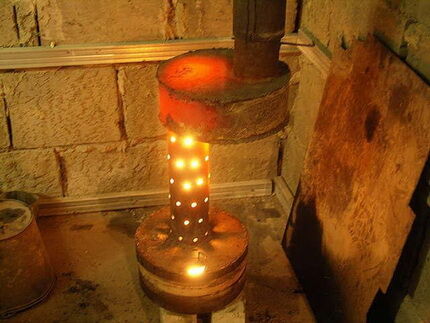
Boilers are designed to heat a coolant, usually water.
There are two types of equipment:
- double-circuit — capable of heating water for domestic needs and heating the coolant;
- single-circuit - “responsible” only for heating.
Automatic heat generators are classified as hot water boilers. They are equipped with an automation system that controls the operation of the device.
Automation for boilers during testing can perform different functions. This can be control over the air temperature in a heated room, control of heating of the coolant, etc.
Boilers for testing with or without automation are made exclusively in the floor-standing version. Their cost varies significantly depending on the functionality. However, in any case, it is quite large, so home craftsmen assemble such devices with their own hands.
How does a heating device work?
The design of the boiler is extremely simple. It includes two chamber compartments: evaporation and combustion. In the first, the process of preparing the oil for combustion occurs, in the second, it burns.
Everything happens as follows. From the waste reservoir, the pump supplies used oil to the evaporation chamber, which is located at the bottom of the device. Here, a temperature is maintained sufficient for the waste to heat up and begin to evaporate.
Oil vapor rises to the upper part of the housing, where the combustion chamber is located. It is equipped with an air duct, which is a pipe with holes. Using a fan, air is supplied through the duct and mixed with oil vapor.
The oil-air mixture burns almost without a residue - the resulting heat warms up the heat exchanger, and the combustion products are sent to the chimney.
Preheating the oil is an essential part of the process.You need to understand that the waste contains a large amount of impurities and toxic substances. All this is broken down into simple carbohydrates, which are subsequently burned.
After which water vapor, carbon dioxide and nitrogen are formed - completely harmless elements. However, this result is only possible if certain temperature conditions are met.
Complete oxidation or combustion of hydrocarbons occurs only at a temperature of +600°C. If it is lower or higher by 150-200°C, then during the combustion process a large number of various toxic substances are formed. They are unsafe for humans, so the combustion temperature must be strictly observed.
Design details of homemade equipment
The most important component of combustion technology is oil preheating. This makes it possible to decompose “heavy” fuel into lighter components. Properly selected parameters allow you to achieve almost smokeless and complete combustion of used oil.
Home craftsmen believe that the easiest way to achieve this result is to use a thick-walled hot metal bowl into which the waste is fed in drops.
When the oil touches the hot metal, it immediately turns into vapor, which is sent into the combustion chamber. For better combustion they need to be mixed with air. An air duct is used for this purpose.
An impeller is installed at its mouth to create the flow turbulence necessary for the oil-air mixture to remain in the combustion chamber for a sufficiently long time. Only in this case will the fuel supplied to the bowl burn completely.
A certain difficulty in the process of activating the operation of the heating device is the heating of the evaporation bowl.
The easiest way to do this is to put a wick soaked in any flammable composition inside the tank. Then pour some gasoline or diesel fuel into the bottom of the bowl and set it on fire. After the metal heats up to the desired temperature, the oil supply begins. This is the simplest, but rather dangerous method.
Another difficult aspect to implement is the oil supply. On the Internet and other open sources you can find many examples of boilers operating on waste oil, where the waste is supplied by a jet.
Yes, such a system is functional, but it is extremely dangerous for the user. The oil supplied by the jet does not have time to burn. A large amount of toxic substances are formed that can enter the room. And this is very dangerous.

For efficient smokeless combustion of waste, it is necessary to organize a drip supply of oil. This is quite difficult, but quite solvable. The optimal method of drip supply, according to home craftsmen, is as follows.
You need to take a hose that will act as an oil line. A filter must be attached to one end to clean the fed waste from impurities and contaminants.
This should be a full filtration automobile oil filter. The latter is very important. Not partial, but complete. You need to be prepared for the fact that you will have to change it often. On average once every 30 days, or even more often. Everything will depend on the quality of the fuel used.
Some difficulty may arise in the process of attaching the unit. It is equipped with a thread with which it is fixed in the car.
You can do the following. You should find a small piece of oil-resistant hose, the diameter of which will coincide with the thread cross-section, and put it on the filter. The resulting unit is connected to the oil pipeline using a fitting.
It is very important that excess oil does not accumulate in the oil supply hose, otherwise drip feed will be impossible.
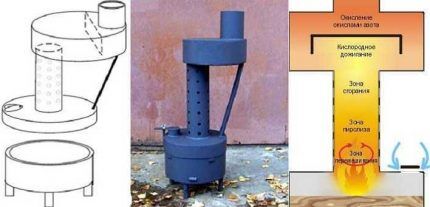
As an option, you can select a pump of such power that it delivers only the required amount of waste. But it is so hard. A simpler option is used in industrially assembled boilers. This is a simple design of tees, fittings and nipples.
With its help, you can easily adjust the supply of the required amount of oil. The excess will be returned to the fuel tank.
The last element of the drip supply system is a fragment of a medical dropper. You need to take a section with a wheel-regulator. The element will allow you to control the speed and frequency of fuel supply to the bowl. The dropper fragment is securely fixed to the fitting.
It is optimal that the waste does not smoke and burns steadily. This is only possible if the oil has normal fluidity. To do this, its temperature must be within 10-20°C.
You need to know that with each change in the composition of the waste or its temperature, you will have to reselect the frequency and speed of the droplet supply of oil. It will not be possible to supply fuel directly from the dropper to the combustion chamber.It is directed into a funnel connected to a pipe that supplies fuel to the bowl.
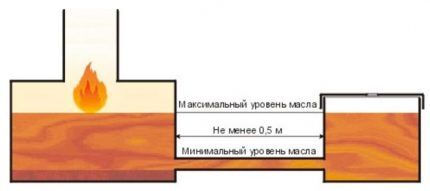
The design of the boiler may vary. It can be connected to the heating system pipes. A prerequisite in this case is pump installation to ensure efficient coolant circulation.
If you install a so-called water jacket around the device, it will heat the water. If there is only one water circuit, the boiler will only serve heating. If there are two circuits, hot water will also be supplied.
Another option is a built-in heat exchanger in the shape of the letter U. It is placed in the upper part of the firebox and connects to a remote tank that will contain hot water. Alternative option - accommodation heat exchanger on the chimney.
The exhaust boiler can be pyrolysis.Its main feature is the ability to operate for a long time on one load of fuel. Structurally, such a model will differ in the presence of an afterburner chamber.
This is where the final combustion of all the chemical elements that make up the used oil takes place. Due to the presence of an afterburning chamber, the operating time pyrolysis boiler per serving of oil increases significantly.
How to make your own boiler
To make a heating device we will need the following materials and tools. We prepare sheet steel with a thickness of at least 4 mm, fittings with a cross-section of 10 or 8 mm, a pipe for the air duct, tees, bends and half-inch corners for the burner, steel adapters, a compressor, an expansion tank and a pump.
In addition, you will need welding equipment, heat-resistant sealant, asbestos cloth and a grinder.
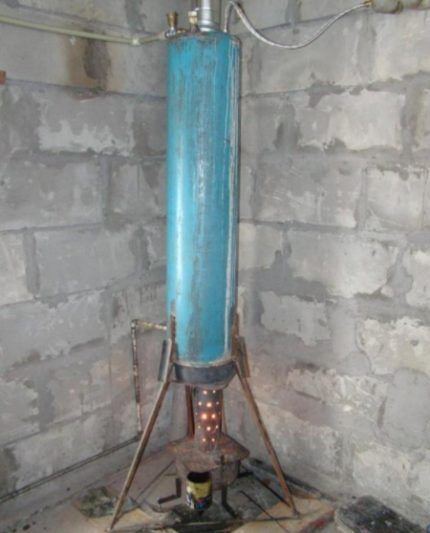
Let's look at the process of making the simplest homemade boiler for testing. The device itself can take different forms. In this regard, to make work easier, you can take not sheet steel, but a piece of large-section pipe with thick walls.
For example, a functional device that can easily heat a standard-sized garage is made from two pipe fragments. One with a cross-section of 0.5 m, the second - 0.2 m.
In addition to them, you will need two more metal plates with a thickness of at least 3 mm, cut in the shape of a circle. If you need a more powerful heating device, then parts of the required dimensions are selected or made from sheet steel.
Now you can proceed to assembly. We start by preparing the body. It will be made of a larger cross-section pipe.We cut it with a grinder so that we get a fragment about a meter high.
We also cut off the smaller cross-section pipe. So that we get a fragment 20 cm high. Now we prepare the plates that will function as the bottom and lid of the case.
In one of them we make a hole corresponding in size to the chimney. This will be the housing cover. In the other we cut a hole for connection with a fragment of a small pipe. This will be the bottom of the structure.
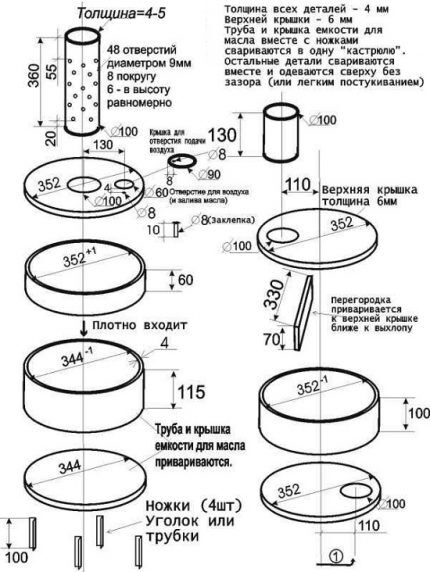
We weld a cylinder cut from a pipe of smaller diameter to it. We cover its bottom with another round plate. We assemble the body, covering it with plates on both sides. We connect the parts and scald them in a circle.
We attach legs made of reinforcing bars to the bottom of the body. We drill ventilation holes in the pipe. We received a cylindrical boiler, in the lower part of which there is a small reservoir.
Now you need to arrange the door. We cut it out at the bottom of the cylinder using a grinder. We place and secure the chimney on the upper part of the body. The simplest version of the boiler is ready.
To light it, you will need to pour a little waste into the lower container and set it on fire with a burning paper wick. This is the simplest of all known options. It is possible to assemble a more complex, and therefore more effective, design.
The actual schematic diagram of any fuel device during testing consists of two boxes made of durable metal, connected to each other by an air duct in the form of a perforated pipe.
The lower box is equipped with a hole through which oil is poured into the evaporation chamber; a damper is usually located opposite it.The upper box is equipped with a hole into which the chimney pipe is inserted.
It is very easy to supplement such a scheme with a variety of components: an oil supply pump, a drip feed for waste, an air compressor, or connect a supply tank with fuel to the boiler.
You can also connect the water circuit. But in this case, it will be necessary to install an efficient burner that can heat the coolant as uniformly as possible.
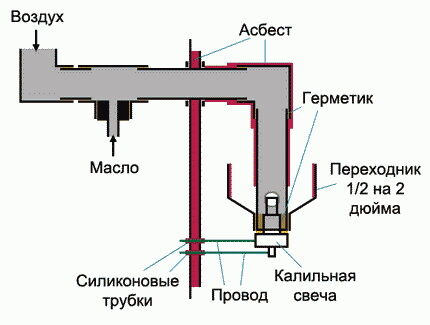
Let's consider the manufacturing process of such a burner. In fact, its shape can be arbitrary, but it must be remembered that the mixing zone should always be located only above the combustion zone.
Only in this case will unused waste be returned to the reservoir. To make the burner body, we take half-inch corners and connect them using tees and bends.
For the oil pipeline supplying waste, you will additionally need adapters for the fitting. Before tightening, coat all threaded connections well with heat-resistant sealant. For the burner cover we use sheet steel. Sheet thickness is at least 3 mm.
We cut out a part from it that corresponds to the size of the socket on the boiler. After we have assembled the burner, all that remains is to install it correctly. To do this, we will prepare two steel plates, one should be slightly smaller than the other, nuts, bolts and asbestos sheet. The half-inch tubes and the inner surface of the adapter must be covered with asbestos. Be sure to secure the canvas.
We glue it with silicate sealant in two layers, and fix the asbestos on the pipes with steel wire. Now we take the burner and insert it into the housing, if necessary, adjust it to the installation socket.
After the burner is “in place,” we install the smaller plate in the socket and cover it with several layers of asbestos sheet. It is optimal if there are four or five of them.
We use the large plate as a fastening pad. We drill several holes in it for fasteners, after which we lay it on top of the asbestos and screw both plates together.
You must understand that the resulting connection should be as tight as possible; if this is not the case, the burner elements may move from place during operation. To ignite such a burner, a standard glow plug is used, which is used in diesel engines.
In a simplified version, the exhaust boiler is a stove to which a heat exchanger or tank is connected to heat the coolant. The following selection of photos will introduce you to the process of making a homemade stove:
The upper part of our homemade stove is ready. Now you need to assemble the lower part and connect the components:
Since the homemade stove we built initially does not have a heat exchanger, we weld it separately and attach it to the upper chamber of the device:
This is just one example of making a tank for heating coolant with a stove during mining. In fact, there are a huge number of assembly options. The main thing is to choose a design suitable for implementation and calculate the required coolant displacement.
Interesting options for making homemade heating devices that work on mining are described in these articles:
- Stove using waste oil from a pipe: how to make an effective stove using waste oil from scrap materials
- How to make a potbelly stove using waste oil with your own hands: options and examples of making a stove
- DIY waste oil heat gun: step-by-step manufacturing instructions
A little about safe operation
Heating devices operating during mining are quite dangerous in operation. This must always be remembered.
To avoid trouble, you should strictly follow a few simple rules:
- The room where the heating device is installed must be equipped with effective ventilation.
- The boiler must be equipped with a well-designed and executed chimney that removes combustion products without residue. It must have a damper.
- The passage of the smoke exhaust through the roof is carried out by installing a special casing.
- The boiler must be installed in accordance with fire safety requirements.
- Storing flammable and flammable materials near the heating device is strictly prohibited.
The boiler during testing, like any other heating device, must be treated with care. Carry out all necessary preventive work in a timely manner, then problems with operation and its safety will not arise.
Conclusions and useful video on the topic
How to independently assemble a boiler for mining:
Exhaust boiler with connected water circuit:
Another design option for such a boiler:
Heating equipment for testing is a practical solution for organizing heating of utility or garage premises. More complex models, equipped with automation that monitors the combustion process and safety, can also be installed as a heating device for the home.
The main advantage of such devices is the use of cheap, sometimes free, fuel, which makes their use as profitable as possible for the owner.
If you have experience making a waste oil boiler, please share the information with our readers. Leave comments on the article and add photos of your homemade products in the form below.
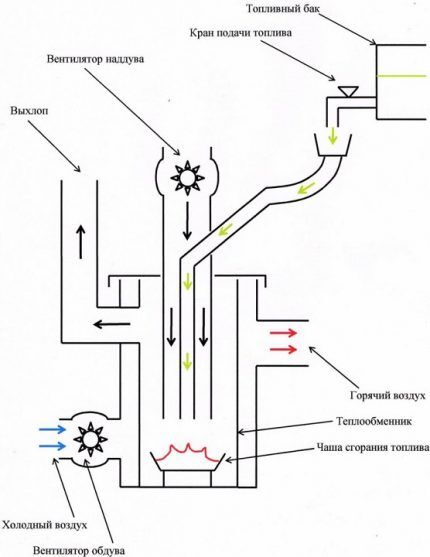
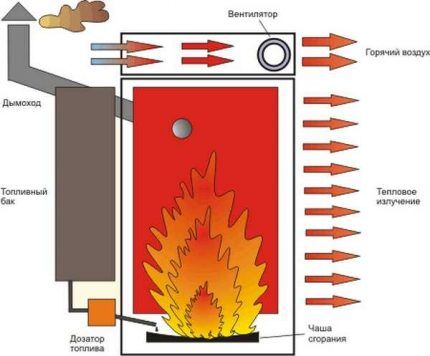




This kind of technology scares me.Of course, I’m not a pro, but even if you don’t observe fire safety, there’s still a decent risk. The provided drawings and assembly diagrams must be executed perfectly accurately. Well, I don’t believe that it’s possible to freeze it at home without making mistakes. Plus ventilation. Practice shows that air flows move differently in each house. In general, I don’t trust these advanced “potbelly stoves”. IMHO, maybe I'm wrong.
I want to try to make such a boiler for testing in my garage, but I talked with a neighbor and some other acquaintances and had my doubts. They are frightened by the unsafety of such stoves, and their economic feasibility, they say, is questionable. Are there anyone who has experience using a similar stove? I think that the fire danger is exaggerated, if done properly, then there is no need to be afraid.
My friend's garage is quite large. Two cars fit without any problems. And the ceilings there are high, about three meters. So he has a homemade boiler and 76 pipes around the entire perimeter, and there is waste in them. So for the past 2 years he has not known grief. The garage is warm and the gas savings are decent. The oil in the pipes takes a very long time to cool down. So I think it makes sense to install such boilers. But this is purely my opinion.
Are you sure you're not confusing anything? Exhaust is fuel for the boiler, which burns and produces heat. Water or antifreeze is poured into the pipes.
No, Roman is not confusing anything; not only water can be used as a coolant in a heating system.In this case, used oil is used as a coolant in the garage; this is justified by the fact that this liquid does not freeze in the cold. Which is quite relevant for a garage that does not need to be heated around the clock.
However, this solution has its drawbacks:
— increased fire hazard;
- lower heat capacity;
- unpleasant smell.
Still, a solution with water and antifreeze will be more practical; the concentration of the latter should be about 20%. It is safer, the heat capacity is greater relative to used oil, and there is no unpleasant odor.
By the way, here you also need to clarify that when using oil as a coolant, the expansion tank must be 1/3 full. This is due to the large expansion when heated.
I have steam from the boiler passing through a pipe heated to red hot. The result is superheated steam. The water passes through a heat exchanger (from a 200 liter barrel) and is heated. Which I use to heat the greenhouse. I didn’t buy anything. I made the stove and boiler myself. An armful of firewood and warmth for a day. A 4 by 8 meter greenhouse is located on the bathhouse. If you tell everything there will be a lot of writing.